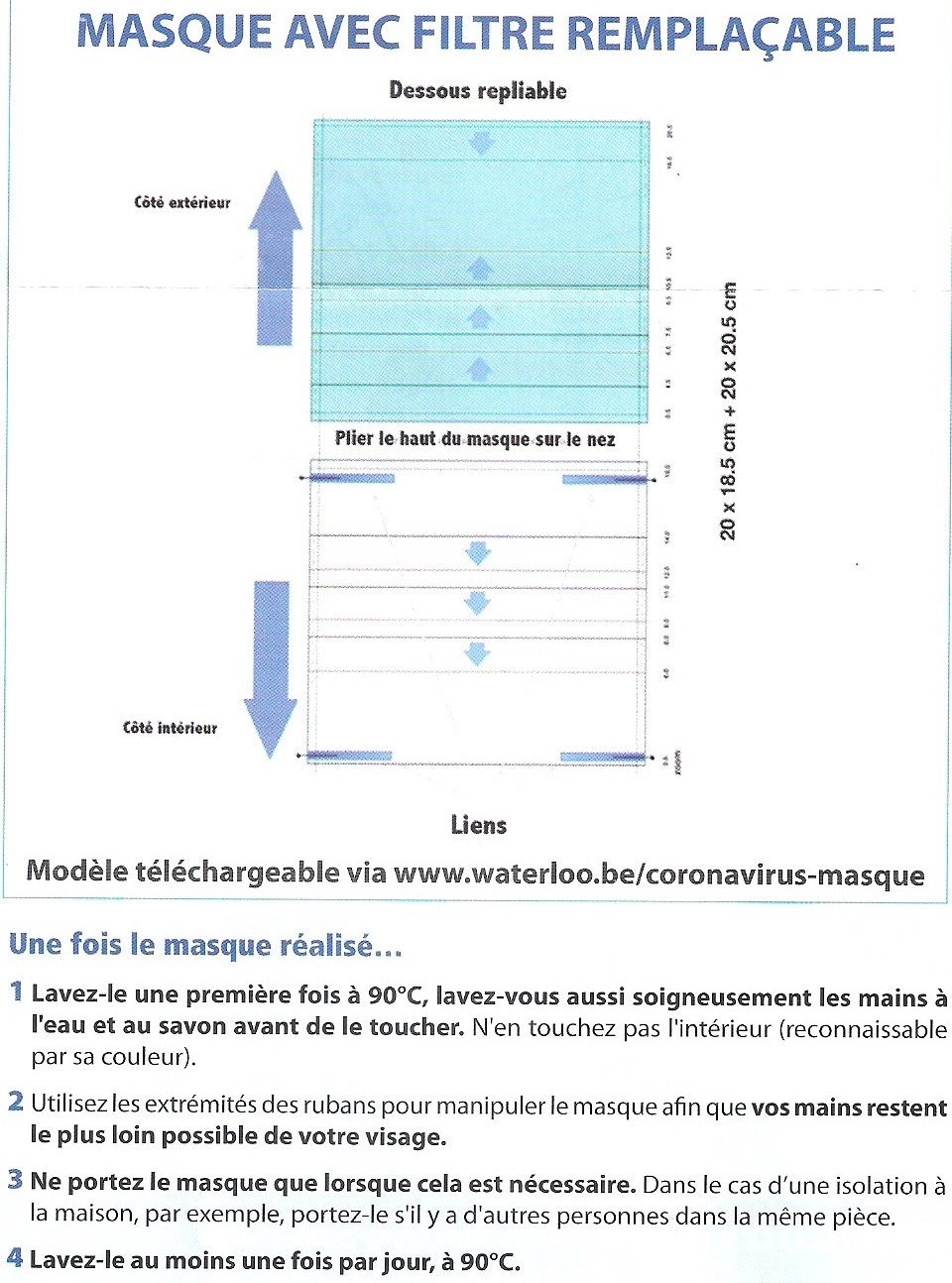Tutoriel validé par le CHU Grenoble pour confectionner un masque en tissu
A diffuser...
@CAudigierValett
C.Audigier-Valette MD/ Pneumo-cancérologue/ Lung cancer /
Clinical Trials/ CHITS TOULON Sainte Musse/ compte professionnel / #COVIDdoctor
Les messages de Clarisse Audigier-Valette
https://twitter.com/CAudigierValett/...65829225627649
https://twitter.com/CAudigierValett/...627649/photo/1
https://twitter.com/CAudigierValett/...627649/photo/2
https://twitter.com/CAudigierValett/status/1238965829225627649/photo/3
Twitter redirige surement, il faut cliquer sur les 3 images, explications, patron et visage masqué.
Liens directs
https://www.moureau.me/c19/mask3.jpg
-----------
Tous les types de masques réduisent l'exposition 'aux aérosols'...
All types of masks reduced aerosol exposure...
LIEN nih.gov TRADUIT EN FRANCAIS
https://translate.google.fr/translate?langpair=en%7Cfr&sl=en&tl=fr&u=https%3A% 2F%2Fwww.ncbi.nlm.nih.gov%2Fpubmed%2F18612429
PLoS One. 2008 Jul 9;3(7):e2618. doi: 10.1371/journal.pone.0002618.
Professional and home-made face masks reduce exposure to respiratory infections among the general population.
van der Sande M1, Teunis P, Sabel R.
Author information
Abstract
BACKGROUND:
Governments are preparing for a potential influenza pandemic. Therefore they need data to assess the possible impact of interventions. Face-masks worn by the general population could be an accessible and affordable intervention, if effective when worn under routine circumstances.
METHODOLOGY:
We assessed transmission reduction potential provided by personal respirators, surgical masks and home-made masks when worn during a variety of activities by healthy volunteers and a simulated patient.
PRINCIPAL FINDINGS:
All types of masks reduced aerosol exposure, relatively stable over time, unaffected by duration of wear or type of activity, but with a high degree of individual variation. Personal respirators were more efficient than surgical masks, which were more efficient than home-made masks. Regardless of mask type, children were less well protected. Outward protection (mask wearing by a mechanical head) was less effective than inward protection (mask wearing by healthy volunteers).
CONCLUSIONS/SIGNIFICANCE:
Any type of general mask use is likely to decrease viral exposure and infection risk on a population level, in spite of imperfect fit and imperfect adherence, personal respirators providing most protection. Masks worn by patients may not offer as great a degree of protection against aerosol transmission.
PMID: 18612429 PMCID: PMC2440799 DOI: 10.1371/journal.pone.0002618
[Indexed for MEDLINE] Free PMC Article
A diffuser...
@CAudigierValett
C.Audigier-Valette MD/ Pneumo-cancérologue/ Lung cancer /
Clinical Trials/ CHITS TOULON Sainte Musse/ compte professionnel / #COVIDdoctor
Les messages de Clarisse Audigier-Valette
https://twitter.com/CAudigierValett/...65829225627649
https://twitter.com/CAudigierValett/...627649/photo/1
https://twitter.com/CAudigierValett/...627649/photo/2
https://twitter.com/CAudigierValett/status/1238965829225627649/photo/3
Twitter redirige surement, il faut cliquer sur les 3 images, explications, patron et visage masqué.
Liens directs
https://www.moureau.me/c19/mask3.jpg
-----------
Tous les types de masques réduisent l'exposition 'aux aérosols'...
All types of masks reduced aerosol exposure...
LIEN nih.gov TRADUIT EN FRANCAIS
https://translate.google.fr/translate?langpair=en%7Cfr&sl=en&tl=fr&u=https%3A% 2F%2Fwww.ncbi.nlm.nih.gov%2Fpubmed%2F18612429
PLoS One. 2008 Jul 9;3(7):e2618. doi: 10.1371/journal.pone.0002618.
Professional and home-made face masks reduce exposure to respiratory infections among the general population.
van der Sande M1, Teunis P, Sabel R.
Author information
Abstract
BACKGROUND:
Governments are preparing for a potential influenza pandemic. Therefore they need data to assess the possible impact of interventions. Face-masks worn by the general population could be an accessible and affordable intervention, if effective when worn under routine circumstances.
METHODOLOGY:
We assessed transmission reduction potential provided by personal respirators, surgical masks and home-made masks when worn during a variety of activities by healthy volunteers and a simulated patient.
PRINCIPAL FINDINGS:
All types of masks reduced aerosol exposure, relatively stable over time, unaffected by duration of wear or type of activity, but with a high degree of individual variation. Personal respirators were more efficient than surgical masks, which were more efficient than home-made masks. Regardless of mask type, children were less well protected. Outward protection (mask wearing by a mechanical head) was less effective than inward protection (mask wearing by healthy volunteers).
CONCLUSIONS/SIGNIFICANCE:
Any type of general mask use is likely to decrease viral exposure and infection risk on a population level, in spite of imperfect fit and imperfect adherence, personal respirators providing most protection. Masks worn by patients may not offer as great a degree of protection against aerosol transmission.
PMID: 18612429 PMCID: PMC2440799 DOI: 10.1371/journal.pone.0002618
[Indexed for MEDLINE] Free PMC Article




 … voici le tuto couture #1 .. étape par étape ….
… voici le tuto couture #1 .. étape par étape …. 





 Oui,tu as raison.Mais je ne suis pas certaine non plus qu'un filtre à café résiste aux lessives......Pfff.......
Oui,tu as raison.Mais je ne suis pas certaine non plus qu'un filtre à café résiste aux lessives......Pfff.......



Commentaire